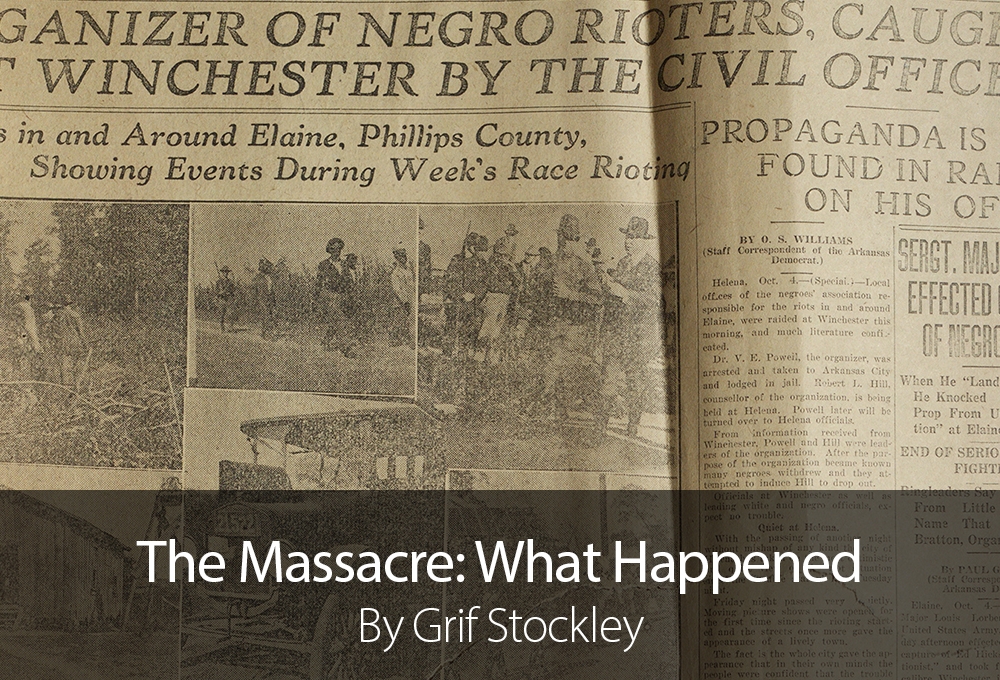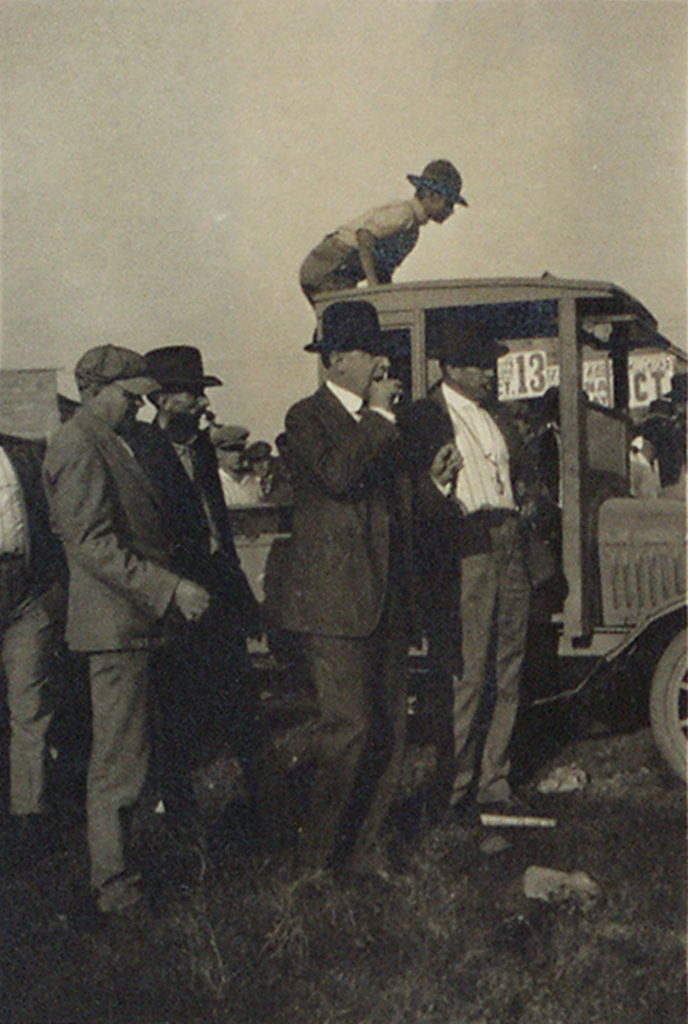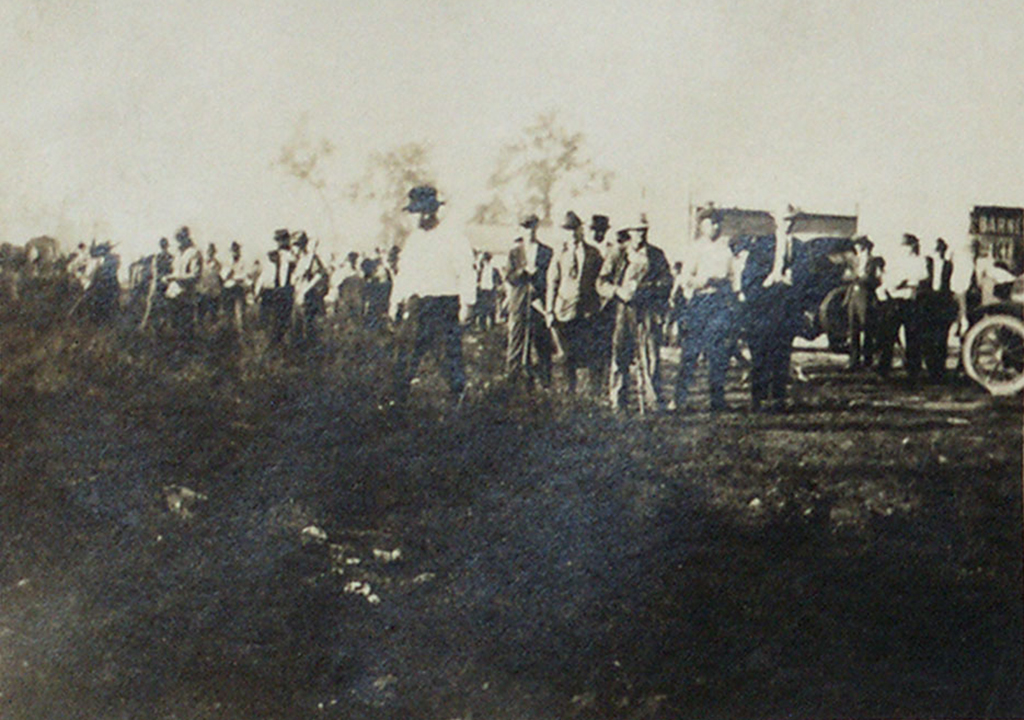On the night of September 30, 1919, gun violence broke out during a union meeting at a church in Hoop Spur between Progressive Farmers and Household Union of America (PFHUA) members and Phillips County law enforcement officers. Will Adkins, a white security officer for the Missouri-Pacific Railroad, was killed. Charles Pratt, a white deputy sheriff, was wounded. Later reports held some PFHUA members and their families within the church were wounded and killed in the gunfire. Kid Collins, a black trustee who was with Adkins and Pratt, was unharmed in the shooting and made his way to a nearby store where he called authorities in Helena to report the incident. At approximately 2 am on October 1st, hours after the initial gunfire outside the Hoop Spur church, Phillips County law enforcement sent a deputized posse from Helena to investigate the shooting. Arkansas newspapers declared a race riot was in motion in the county. Governor Charles Brough received a telegram requesting troops. Brough petitioned the War Department in Washington for troops to be sent to Elaine from Camp Pike in North Little Rock.
Throughout that same morning word of blacks fighting back reached across the Delta, leading to hundreds of armed white men pouring into Phillips County from outside the area with the sole purpose of hunting down blacks. Later that day a sheriff deputy reported that Elaine was under attack by a group of armed blacks. No white casualties occurred in town. White women and children were put on a train to Helena for safety. Ocier Bratton, who was getting signed retainer agreements and fees from black sharecroppers, was arrested in Ratio and taken to Elaine. He was also moved to Helena for safety once Phillips County Judge J.M. Jackson feared Bratton would be lynched. Bratton later reported that Elaine was quiet and that he did not see armed blacks attacking anyone.
Meanwhile, blacks in the area fled into hiding within the surrounded woods and canebrakes. Their homes were ransacked. Robert Hill, founder of the PFHUA and with Bratton in Ratio, escaped, fleeing the state. Outside of Elaine two posse members, Clinton Lee and James Tappen, were killed while hunting down blacks. The Johnston brothers, members of a prominent black family in Helena, were murdered en route to Helena after being forcibly removed from a train by a white posse. Posse member O.R. Lilly was also killed. There were conflicting reports on how everyone in this situation died. By evening of October 1, hundreds of armed posse members are in Phillips County shooting blacks indiscriminately, the mounting black death toll unknown. Four white men were dead at this point. Late that night, the troop train left from Little Rock to Elaine carrying 550 infantrymen to deal with alleged black insurrectionists.
Commanding officer Colonel Jenks led the troops that arrived in Elaine on the morning of October 2. Jenks ordered everyone, black and white, to be disarmed. With Elaine secured and Jenks sent a detachment to Helena to guard the jail where blacks were rounded into to prevent lynchings. He then goes to Hoop Spur with a company of men and two machine guns. One of his men, Corporal Luther D. Earls, was killed but Jenks’ report did not include any mention of his men firing shots. Earls was the last white casualty from the event, a total of five white men. Having accepted the rumored black insurrection as told by whites, Jenks’ soldiers aided in interrogating black prisoners, including torture. Hundreds of blacks were put in stockades, only released after their white employers vouched for them. Military intelligence reports didn’t include the names of blacks interrogated and tortured but these reports claimed these individuals confessed to planning an insurrection. Blacks were moved from the stockades to the Helena jail where torture continued. Military intelligence reports estimated black deaths at twenty at most. Jenks’ report only noted two blacks killed.
The Committee of Seven, a group of local planters and city and county officials, formed on October 2. They met with Governor Brough that same day to propose leading an investigation into the riot. The committee had no legal authority but Brough agreed their request to head an investigation. Brough returned to Little Rock with the promise that lynchings would not occur in the county. The local press announced that the Committee of Seven was in charge and investigating the riot the next day. Meanwhile, the black toll was casually reported in newspapers without specific details of numbers or who committed the murders. The Arkansas Gazette reported at least fifteen black bodies in Helena’s streets and it’s outskirts. The Memphis Press stated that white locals were so enraged that they were firing bullets into black corpses as they left Helena en route to Elaine. More atrocities were later reported, including cutting souvenirs from black bodies and dragging corpses through the streets. Activities and violence committed by white mobs were not detailed. In Little Rock, Brough held a press conference where he praised the five white men killed but made no mention of white mob activities.
One week after the violence began in Hoop Spur, the Committee of Seven announced their investigation’s findings on October 7th. The committee claimed they discovered a plan of black insurrection set for October 6th that was prematurely enacted on the night of the Hoop Spur church shooting. They further claimed white planters in the area were targeted for death, that blacks expected to seize their land, and that union organizer Robert Hill had knowingly conned blacks for his own personal gain. The same day the committee released their findings, a circular was passed out advising blacks to get back to work as if nothing had happened. Editorials from Arkansas, Tennessee, and Mississippi warned blacks against further involved, adding that it would only result in more blacks deaths. The following day, NAACP field secretary Walter White is nearly lynched in Helena while investigating the massacre. White, who interviewed Brough under the guise of passing for white, wrote several articles for the Northern press regarding the massacre and the conditions blacks lived under in Arkansas. Furious, Brough tried to keep the NAACP magazine the Crisis and the black newspaper the Chicago Defender from distribution in Arkansas.
During the last days of October 1919, the Phillips County grand jury charged 122 blacks with various crimes, from night riding to murder. As trials were carried out in November, it became clear that acting defense attorneys weren’t providing their clients defense. The first six of the Elaine 12 were sentenced to death within minutes on November 3rd. The following day, five more men were sentenced to death, again, within minutes. On November 17th Ed Ware, secretary of the PFHUA’s Hoop Spur lodge, was sentenced to death, the last of the Elaine Twelve.
Header Image: Brough, Charles Hillman Papers, Arkansas State Archives, Little Rock, Arkansas.
About the Essay:
This piece is an abstract from Grif Stockley’s Blood In Their Eyes. Stockley spent years researching the massacre. His 2001 work is the culmination of his research and is often sought out by scholars as well as casual readers interested in the 1919 Elaine Massacre.
About the Author:
Grif Stockley wrote several books about civil rights in Arkansas such as Daisy Bates: Civil Rights Crusader from Arkansas, Blood in Their Eyes: The Elaine Race Massacres of 1919, and Black Boys Burning: Fire at the Arkansas Negro Boys Industrial School. He worked as an attorney on several prominent cases such as Walker v. Department of Human Services that resulted in a court declaring the Arkansas juvenile justice system as unconstitutional. He also wrote several mystery novels. In 2016, the Arkansas branch of the American Civil Liberties Union declared him the Civil Libertarian of the Year.


